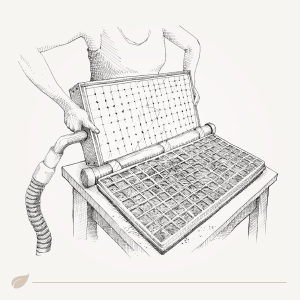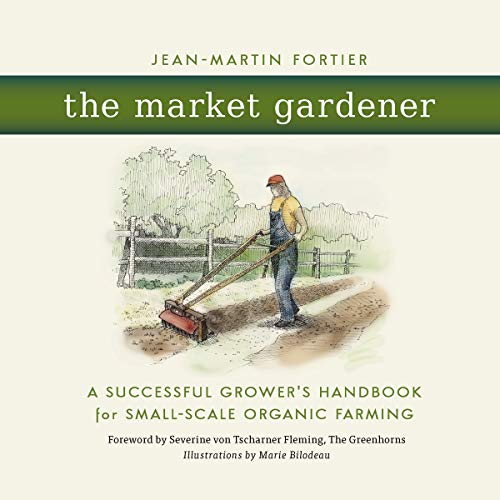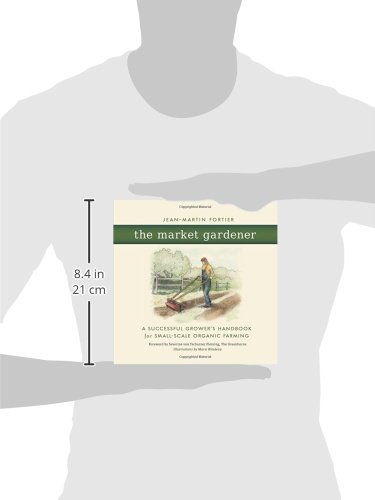The Market Gardener: A Successful Grower’s Handbook for Small-Scale Organic Farming
Grow better not bigger with proven low-tech, human-scale, biointensive farming methods
Les Jardins de la Grelinette is a micro-farm located in Eastern Quebec, just north of the American border. Growing on just 1.5 acres, owners Jean-Martin and Maude-Helene feed more than 200 families through their thriving CSA and seasonal market stands and supply their signature mesclun salad mix to dozens of local establishments. The secret of their success is the low-tech, high-yield production methods they’ve developed by focusing on growing better rather than growing bigger, making their operation more lucrative and viable in the process.
The Market Gardener is a compendium of La Grelinette’s proven horticultural techniques and innovative growing methods. This complete guide is packed with practical information on:
Setting-up a micro-farm by designing biologically intensive cropping systems, all with negligible capital outlay; Farming without a tractor and minimizing fossil fuel inputs through the use of the best hand tools, appropriate machinery and minimum tillage practices; Growing mixed vegetables systematically with attention to weed and pest management, crop yields, harvest periods and pricing approaches.
Inspired by the French intensive tradition of maraichage and by iconic American vegetable grower Eliot Coleman, author and farmer Jean-Martin shows by example how to start a market garden and make it both very productive and profitable. Making a living wage farming without big capital outlay or acreages may be closer than you think.
From the Publisher








Garden Design
We’ve laid out the gardens so that all plots are equidistant from a multi-functional building that houses the washing, processing, and storage areas. This setup maximizes day-to-day productivity by minimizing onsite foot traffic.
Soil Preparation
Covering the soil with an opaque tarp for a few weeks is how we manage to clean the surface of our beds without having to work the soil. This technique is also quite beneficial in reducing weed pressure for the following crop.
Compost
To complete our compost needs, we make our own with crop residues and other available carbonaceous material. When building the pile, we inoculate it with “bokashi” type bacteria, which help to decompose the heap without us having to turn it.






Planting Seeds
To speed up the procedure when seeding flats, we use a homemade vacuum seeder, also known as a plate seeder. This simple yet brilliant device uses a vacuum to hold seeds onto a flat plate drilled with small holes to match the seed size and pattern of cells in a tray. You then flip over the plate onto a filled cell flat and shut the vacuum off, letting the seeds fall into place.
Seedbed Preparation
When cultivating with a hoe, it’s much easier to follow a straight line than a wandering one. This is why we mark our rows. We do so by fitting a few short lengths of interchangeable plastic tubes over the tines of our bed preparation rake. Our row spacing calculation is based on the width of the hoes we use and the optimal spacing for each crop.
Harvesting and Record Keeping
To prevent mistakes from happening again the following year, we record all our observations in a loose-leaf binder with a section for each crop. For each cultivar, we note the actual seeding, planting, and harvesting dates along with the yield produced. We also record the number of beds planted, which allows us to adjust our targets for the following year if necessary. At the bottom of each page, we leave a space to note any other useful observations


Publisher : New Society Publishers; Illustrated edition (March 1, 2014)
Language : English
Paperback : 224 pages
ISBN-10 : 0865717656
ISBN-13 : 978-0865717657
Item Weight : 1.1 pounds
Dimensions : 8.5 x 0.45 x 8.5 inches
$18.89
Price: $18.89
(as of Sep 23, 2023 18:11:13 UTC – Details)
Grow better not bigger with proven low-tech, human-scale, biointensive farming methods
Les Jardins de la Grelinette is a micro-farm located in Eastern Quebec, just north of the American border. Growing on just 1.5 acres, owners Jean-Martin and Maude-Helene feed more than 200 families through their thriving CSA and seasonal market stands and supply their signature mesclun salad mix to dozens of local establishments. The secret of their success is the low-tech, high-yield production methods they’ve developed by focusing on growing better rather than growing bigger, making their operation more lucrative and viable in the process.
The Market Gardener is a compendium of La Grelinette’s proven horticultural techniques and innovative growing methods. This complete guide is packed with practical information on:
Setting-up a micro-farm by designing biologically intensive cropping systems, all with negligible capital outlay; Farming without a tractor and minimizing fossil fuel inputs through the use of the best hand tools, appropriate machinery and minimum tillage practices; Growing mixed vegetables systematically with attention to weed and pest management, crop yields, harvest periods and pricing approaches.
Inspired by the French intensive tradition of maraichage and by iconic American vegetable grower Eliot Coleman, author and farmer Jean-Martin shows by example how to start a market garden and make it both very productive and profitable. Making a living wage farming without big capital outlay or acreages may be closer than you think.
From the Publisher








Garden Design
We’ve laid out the gardens so that all plots are equidistant from a multi-functional building that houses the washing, processing, and storage areas. This setup maximizes day-to-day productivity by minimizing onsite foot traffic.
Soil Preparation
Covering the soil with an opaque tarp for a few weeks is how we manage to clean the surface of our beds without having to work the soil. This technique is also quite beneficial in reducing weed pressure for the following crop.
Compost
To complete our compost needs, we make our own with crop residues and other available carbonaceous material. When building the pile, we inoculate it with “bokashi” type bacteria, which help to decompose the heap without us having to turn it.






Planting Seeds
To speed up the procedure when seeding flats, we use a homemade vacuum seeder, also known as a plate seeder. This simple yet brilliant device uses a vacuum to hold seeds onto a flat plate drilled with small holes to match the seed size and pattern of cells in a tray. You then flip over the plate onto a filled cell flat and shut the vacuum off, letting the seeds fall into place.
Seedbed Preparation
When cultivating with a hoe, it’s much easier to follow a straight line than a wandering one. This is why we mark our rows. We do so by fitting a few short lengths of interchangeable plastic tubes over the tines of our bed preparation rake. Our row spacing calculation is based on the width of the hoes we use and the optimal spacing for each crop.
Harvesting and Record Keeping
To prevent mistakes from happening again the following year, we record all our observations in a loose-leaf binder with a section for each crop. For each cultivar, we note the actual seeding, planting, and harvesting dates along with the yield produced. We also record the number of beds planted, which allows us to adjust our targets for the following year if necessary. At the bottom of each page, we leave a space to note any other useful observations


Publisher : New Society Publishers; Illustrated edition (March 1, 2014)
Language : English
Paperback : 224 pages
ISBN-10 : 0865717656
ISBN-13 : 978-0865717657
Item Weight : 1.1 pounds
Dimensions : 8.5 x 0.45 x 8.5 inches

$18.89






